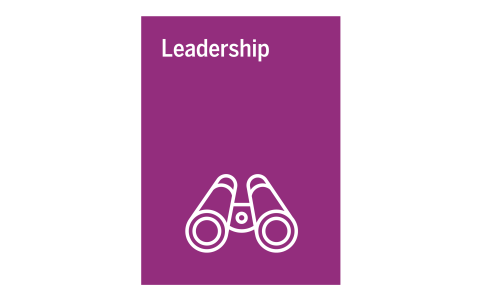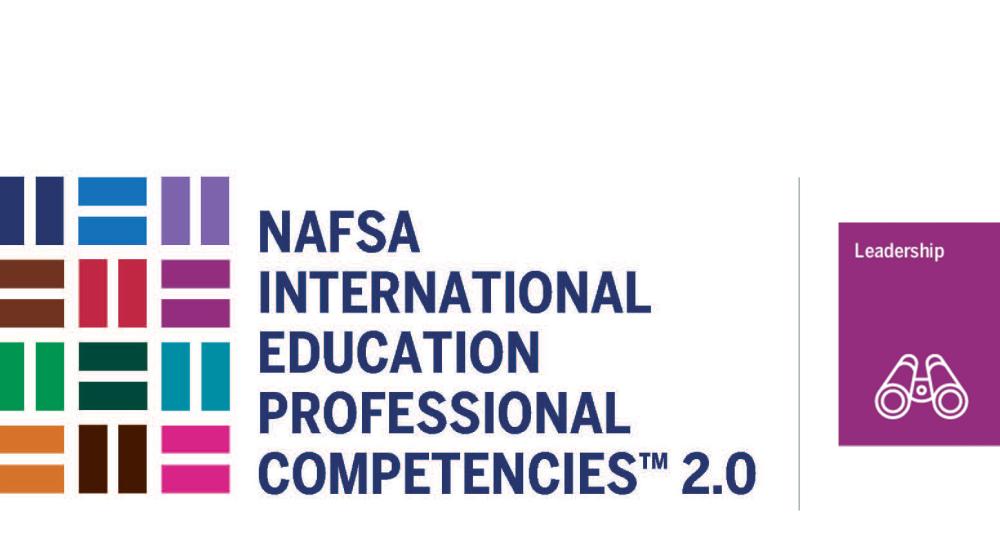Thinking Big with Transformational Leadership
Like many leaders coming into a new role, Ashley Neyer restructured the team at Louisiana State University (LSU) when she took over as study abroad director, but the changes went beyond reshuffling the org chart. By empowering each staff member to develop relationships and build partnerships with different colleges across the university, Neyer helped shift the team’s mindset from focusing not only on its role in international education, “but how in the overall higher education context we can be contributors to broadening thought and helping our colleagues work through cultural differences,” says Neyer.
Leadership strategies come in many flavors, but in an increasingly volatile world, the ability to think big—and inspire others to do the same—has taken on greater importance. Often called “transformational leadership,” this approach upends many conceptions of what leadership means, replacing them with aspirational goals that mirror those of international education itself, including inclusion, personal growth, and a vision of what’s possible with a global outlook.
“So often when we think of leaders, we think linearly—can you execute a task?” says Raquel Dailey, founder of Best Life Abroad. “Transformational leadership creates a collective vision for the future where everyone’s empowered. You don’t have to pull people along, because everyone’s equally invested.”
“Transformational leadership creates a collective vision for the future where everyone’s empowered. You don’t have to pull people along, because everyone’s equally invested.” —Raquel Dailey
And for a field that in less than a decade has had to navigate drastic shifts in immigration policies, a global pandemic, ongoing staff shortages, calls for greater inclusion, and the broader existential travails of higher education, transformational leadership may be exactly what’s needed to meet challenges in the years to come.
“We need to communicate what international education can be and will be,” Dailey says. “This is really important for the longevity and relevance of the field. But if we have leaders who are linearly thinking and not collectively inclusive, we will have a field that will dwindle.
Leadership Fit for the Field
The concept of transformational leadership is generally believed to have been introduced by sociologist James V. Downton, popularized by presidential biographer James MacGregor Burns, and systematized into a business leadership context by scholar Bernard M. Bass. At the highest level, it focuses on leaders who can work with stakeholders to identify needed change and then inspire them to do what’s necessary to meet it. Doing so requires a combination of institutional savvy and personal inspiration.
“When I think about transformational leadership, I think about individuals who understand how change works in an organization and know how to lead whatever kind of change they want to get the results they want to see,” says John Hildebrand, founder and principal of Hildebrand Consulting and a former manager of international student advising services at Colorado State University. Adds Dailey, “It’s an ability to inspire and motivate people around you and to leverage their authentic talent—areas where they naturally excel and are drawn to within the team and the people around you to achieve that goal you’re trying to pursue.”
“It’s an ability to inspire and motivate people around you and to leverage their authentic talent.” —John Hildebrand
These attributes are especially important in the current moment in international education and higher education writ large. “I see a lot of need for those competencies because the landscape can change really dramatically—political shifts, administrative shifts, regulatory and institutional changes—and [we’re] looking at how international education can continue to be impactful in a world that’s changing so quickly,” Hildebrand says. “Leaders need to know how to facilitate change—and in some cases, rapid change—in institutions not used to changing quickly.”
The focus on inclusivity in this kind of leadership also mirrors the growing importance of broadening international education so it includes students who have historically not participated in global learning. “Finally, our field is going deep in these areas, and leaders need to understand the issues,” says Sora H. Friedman, professor of international and global education at the SIT Graduate Institute.
Dailey points to the example of Emerson College’s James Baldwin Writers’ Colony at Kasteel Well, a study abroad program in the Netherlands designed for students of color at Emerson and historically Black colleges and universities. “It changes the scope of interest,” she says. “You can have a program that is still in Europe, focused on improving student writing, but it expands who might be interested, who might feel like they have a sense of belonging in the space.”
Becoming a Transformational Leader
The attributes of transformational leadership don’t always fit neatly into frameworks or checklists, but international educators point to certain strategies and tools that can drive change.
Start with yourself.
Because transformational leadership calls on leaders to inspire others, self-reflection and introspection are “crucial but often overlooked aspects of transformational leadership,” Dailey says. “If you’re not self-aware, you’re not able to do any of these things, and if you’re not able to read the room as a leader, you’re not going to be successful.”
Not coincidentally, international educators seek to model introspection and related practices/skills—including self-awareness, cultural sensitivity, and collaboration with members of diverse populations—for their students. “We are privileged in that we have unique experiences, interactions, and observations we don’t get in traditional work settings,” Dailey says.
Many leadership programs begin with self-reflection exercises, such as the CliftonStrengths assessment, which identifies individuals’ strengths and encourages introspection. But transformational leadership takes this a step further, as it implies being open to change based on these insights.
“We can’t show up as our best leader selves if we’re ignoring our body, the contexts that exist, and the spiritual self.” —Sora H. Friedman
“To be a transformative leader, I think one needs to be willing to undergo a transformation themselves, which requires a willingness to embrace personal change, genuine self-reflection, and strong resonant relationships with others who can support and guide them through the process,” Hildebrand says. “I don't think transformative leadership is a leadership style you can just ‘switch on.’ In my opinion, it has to come through embracing personal transformation.”
To get to this point, Friedman points to the value of somatic leadership, which taps into the mind-body connection to identify physical, emotional, and mental patterns that can lead to personal transformation. “We can’t show up as our best leader selves if we’re ignoring our body, the contexts that exist, and the spiritual self,” she says.
Recognize that problem-solving isn’t the only leadership skill that matters.
Leadership theory has historically focused on developing skills around pinpointing and resolving problems. Transformational leaders focus instead on strength, emotional intelligence, and the idea that “change doesn’t have to happen by remediating weaknesses,” Hildebrand says.
Transformational leaders center the cultivation of curiosity by asking questions that reveal different viewpoints and the untapped potential in the people around them. Sometimes called “appreciative inquiry,” this approach can lead to change in a more generative way, says Hildebrand.
“It’s the question, not the response, that drives the momentum for change,” he says. “Asking how to drive powerful, appreciative questions is critical.”
Focus on opportunities.
Transformational leadership relies on a vision for change, but too often leaders focus on deficits. Consider the traditional decision-making framework that looks at strengths, weaknesses, opportunities, and threats (SWOT), placing placing the positive and the negative on an equal footing.
Instead of SWOT, transformational leaders often focus on SOAR: strengths, opportunities, aspirations, and results. When they do, “you’ll feel a difference in the room,” Hildebrand says.
“It’s really important to have leaders willing to advocate for equity and access—it’s the only way forward.” —Raquel Dailey
For leaders in international education, it’s important to understand the current state of the field to identify opportunities. “Transformation cannot be conceptualized—it won’t work,” Friedman says. “Things change monumentally and quickly. Understanding what students are engaged with, worried about, and looking forward to learning is critical. If I try to think about transforming myself as a leader without thinking of the context, it won’t have impact.”
One key opportunity transformational leaders have gravitated to is expanding access to international opportunities, according to Dailey. “It’s really important to have leaders willing to advocate for equity and access—it’s the only way forward,” she says. “We have to be willing to challenge systemic barriers, [to] promote and create policies that are fair and opportunities that are supportive. All of this is essential to transformative leadership.”
Understand that people aren’t resistant to change—they’re resistant to being changed.
A key element of transformational leadership is inclusiveness: inspiring others to move toward the desired vision. “If people feel part of what an institution could be, they’re much less resistant to change,” Hildebrand says.
Achieving this requires building authentic relationships at all levels. “I think understanding relationships is really important,” Friedman says. “Leadership is like communication—it takes two.”
Relationship cultivation is particularly important for international education units, which sit within the much larger context of a college or university. “For many of us, we’re a small fish in the big pond of the institution,” says Neyer. “We really need to make sure our team understands what impact we have and how we are tied to the institution’s broader goals.”
Relationship building also extends to students. Transylvania University in Kentucky, where Rachel J. Wilson is director of the one-person Office of Global and Intercultural Engagement, recently added a post-study abroad course and is exploring other opportunities to help returning students share their experiences with peers and faculty beyond simply saying, “It was good,” she says. Wilson says she focuses on empowering students to “gain confidence and independence, starting from their decision to study abroad.”
Stop pointing fingers.
Some leadership strategies focus on tactics to respond to the preferences of different generations in the workplace, which, while insightful, may not always be productive.
“I’m seeing a lot of finger-pointing at the changing demands of people in new generations [rather than] seeing the level of self-reflection to solve the core issue, which is people looking for meaning and purpose and impact in their work,” Hildebrand says. “A lot of institutions are holding on to their status instead of taking a look in the mirror and seeing what they can do to be a place where people can find purpose and develop skills.”
“Most of my team is new to the field, so showing them how they can build their pathways into the field and take opportunities and expand on them is really important.” —Ashley Neyer
Within international education, this tension can be seen in the growing desire for remote and flexible work arrangements, especially among younger staffers, according to Hildebrand. “There’s going to have to be a discussion to figure out where the middle point is, because otherwise leaders stand to lose really good talent,” he cautions.
To attract and retain talent, transformational leaders need to find ways to empower newer professionals. “Most of my team is new to the field, so showing them how they can build their pathways into the field and take opportunities and expand on them is really important,” Neyer says.
Coaching is essential—for your staff and yourself.
Younger workers also expect coaching, which is a skill transformational leaders must develop to support all of their colleagues. “Performance evaluations are not giving people what they want from work,” Hildebrand says. “Coaching provides the support that so many people need to get to the place where they can contribute and create positive change.”
Hildebrand saw this firsthand as a Region II coach for the NAFSA Academy for International Education. As he heard participants talk about how they struggled to balance their professional development plans with their day-to-day responsibilities at their institutions, he focused on “what their ambitions were and what they wanted for the next part of their careers.”
“Who are the leaders you admire, and what do you admire about them?” —Rachel J. Wilson
“A responsibility of a coach is stoking them and reminding them why they want to be there, their vision, and helping them make the needed change—especially when change is happening around us all the time,” he says.
It’s also important for leaders—and those who aspire to lead—to coach themselves. Along with development programs like the Academy and NAFSA’s Management Development Program, international educators should seek out leaders to emulate. “Who are the leaders you admire, and what do you admire about them?” asks Wilson. Write down what is valuable about the person’s approach to leadership, what to replicate, and how do so. Not sure on the steps to take? “Don’t be afraid to call them,” Neyer adds.
Transformational leaders aren’t always leaders
It’s important to remember that by cultivating a positive example, empathy, and inclusion, “you can be a transformational leader in any role in the organization,” says Dailey. “Not all of us want to have classically defined leadership roles,” Friedman adds. “Leadership happens at all levels.”
Those who are senior leaders should identify ways to ensure people working in teams have opportunities to lead. Friedman says this can be as simple as rotating team roles within meeting contexts—setting agendas, taking minutes, timekeeping—and creating the expectation of shared decision-making.
“Everyone [who] I believe is a transformational leader didn’t start that way,” Dailey says. “Their experiences allowed them to grow.”
Leaders who are committed to bringing everyone along will also see growth. “I want to help our team put their instinct of bigger, bolder ideas about bringing more opportunities and awareness to what we’re doing,” Neyer says. •
NAFSA’s International Education Professional Competencies 2.0: Big and Small L’s
Leadership is just one of the 12 essential capabilities for international educators detailed in NAFSA’s International Education Professional Competencies 2.0. But Neyer sees it as the “big L,” which is itself made up of multiple smaller skills found in all elements of transformational leadership. Support, authenticity, and empathy—“the soft skills you don’t necessarily list on a résumé,” she says—“are what really support you in your success.”
And these elements of transformational leadership cut across all 12 of the NAFSA competencies, which were designed “to advance the professionalization of the field and influence how international educators see themselves in the future,” as noted in the corresponding publication.
“I have to be empathetic when working as a member of the team, but I have to be authentic when talking about budgets and business acumen,” Neyer says. “Stretching those softer skills and building them into those competencies and leaning in on them are what is going to make you grow as a leader.”
The best way to do so, adds Wilson, is self-reflection. “Think about your strengths within those competencies and how you express or hope to express the fundamental values [that] make leaders,” she says.
NAFSA Resources
Additional Resources
About International Educator
International Educator is NAFSA’s flagship publication and has been published continually since 1990. As a record of the association and the field of international education, IE includes articles on a variety of topics, trends, and issues facing NAFSA members and their work.
From in-depth features to interviews with thought leaders and columns tailored to NAFSA’s knowledge communities, IE provides must-read context and analysis to those working around the globe to advance international education and exchange.
About NAFSA
NAFSA: Association of International Educators is the world's largest nonprofit association dedicated to international education and exchange. NAFSA serves the needs of more than 10,000 members and international educators worldwide at more than 3,500 institutions, in over 150 countries.
NAFSA membership provides you with unmatched access to best-in-class programs, critical updates, and resources to professionalize your practice. Members gain unrivaled opportunities to partner with experienced international education leaders.















